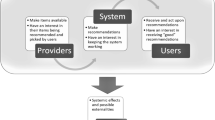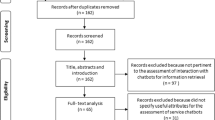Abstract
When used in a mobile ecosystem, social Web applications are commonly criticized due to their poor quality. We believe this is accounted for by the inadequacy of current approaches for their evaluation as well as the lack of suitable quality models. With an objective to address the aforementioned issues, this paper introduces a quality model that captures the particularities of social Web applications when used on mobile devices. Drawing on the comprehensive literature review, a finite set of performance variables (items, attributes, and categories) that contribute to the mobile quality of social Web applications was identified and subsequently employed for the purpose of designing a conceptual model in the form of a mobile quality requirements tree. An empirical study was then carried out to assess the reliability and validity of the conceptual model and pertaining measuring instrument. During the study, participants accomplished predefined scenarios of interaction with a representative sample of social Web applications for collaborative writing and evaluated their mobile quality by completing the post-use questionnaire. An analysis of data collected from end users uncovered a relevance of performance variables at different levels of granularity in a mobile quality requirements tree as well as pros and cons of evaluated collaborative editors.

Similar content being viewed by others
Notes
office.naver.com.
References
Ali, A., Alrasheedi, M., Ouda, A., Capretz, L.F.: A study of the interface usability issues of mobile learning applications for smart phones from the users perspective. Int. J. Integr. Technol. Educ. 3(4), 1–16 (2014). doi:10.5121/ijite.2014.3401
Alshehri, F., Freeman, M.: User experience of mobile devices: a three layer method of evaluation. In: Proceedings of the 25th Australasian Conference on Information Systems, ACIS, Auckland, pp. 1–10 (2014). ISBN: 978-1-927184-26-4
Billi, M., Burzagli, L., Catarci, T., Santucci, G., Bertini, E., Gabbanini, F., Palchetti, E.: A unified methodology for the evaluation of accessibility and usability of mobile applications. Univ. Access Inf. Soc. 9(4), 337–356 (2010). doi:10.1007/s10209-009-0180-1
Brodahl, C., Hadjerrouit, S., Hansen, N.K.: Collaborative writing with Web 2.0 technologies: education students’ perceptions. J. Inf. Technol. Educ. 10, 73–103 (2011)
Brown, M.E., Hocutt, D.L.: Learning to use, useful for learning: a usability study of Google apps for education. J. Usabil. Stud. 10(4), 160–181 (2015)
Brunvand, S.: Facilitating student interaction and collaboration in a MOOC environment. In: Mendoza-Gonzalez, R. (ed.) User-centered design strategies for massive open online courses (MOOCs), pp. 1–14. IGI Global, Hershey (2016). doi:10.4018/978-1-4666-9743-0.ch001
Cochrane, T., Bateman, R.: Smartphones give you wings: pedagogical affordances of mobile Web 2.0. Australas. J. Educ. Technol. 26.1, 1–14 (2010). ISSN 1449-5554
Cohen, J.: A power primer. Psychol. Bull. 112(1), 155–159 (1992). doi:10.1037/0033-2909.112.1.155
Cronbach, L.J.: Coefficient alpha and the internal structure of tests. Psychometrika 16(3), 297–334 (1951). doi:10.1007/BF02310555
Cronbach, L.J., Meehl, P.E.: Construct validity in psychological tests. Psychol. Bull. 52(4), 281–302 (1955). doi:10.1037/h0040957
Fernandes, J.M., Ferreira, A.L.: Quality attributes for mobile applications. In: Rosado da Cruz, A.M., Paiva, S. (eds.) Modern software engineering methodologies for mobile and cloud environments, vol. 1, pp. 141–155. IGI Global, Hershey (2016). doi:10.4018/978-1-4666-9916-8.ch008
Flora, H.K., Wang, X., Chande, S.V.: An investigation on the characteristics of mobile applications: a survey study. Int. J. Inf. Technol. Comput. Sci. 6(11), 21–27 (2014). doi:10.5815/ijitcs.2014.11.03
Gikas, J., Grant, M.M.: Mobile computing devices in higher education: student perspectives on learning with cellphones, smartphones & social media. Internet High. Educ. 19, 18–26 (2013). doi:10.1016/j.iheduc.2013.06.002
Hair, J.F., Ringle, C.M., Sarstedt, M.: PLS-SEM: indeed a silver bullet. J. Market. Theory Pract. 19(2), 139–151 (2011). doi:10.2753/MTP1069-6679190202
Hoehle, H., Aljafari, R., Venkatesh, V.: Leveraging Microsoft's mobile usability guidelines: conceptualizing and developing scales for mobile application usability. Int. J. Hum Comput Stud. 89, 35–53 (2016). doi:10.1016/j.ijhcs.2016.02.001
Hoehle, H., Venkatesh, V.: Mobile application usability: conceptualization and instrument development. MIS Q. 39.2, 435–472 (2015). ISSN: 0276-7783
Huang, K.Y.: Challenges in human-computer interaction design for mobile devices. In: Proceedings of the World Congress on Engineering and Computer Science, IAENG, San Francisco, pp. 20–22. (2009)
Idri, A., Moumane, K., Abran, A.: On the use of software quality standard ISO/IEC 9126 in mobile environments. In: Proceedings of the 20th Asia-Pacific Software Engineering Conference, IEEE, Bangkok, pp 1–8. (2013)
ISO 9241-110 (2006) Ergonomics of human-system interaction—Part 110: Dialogue principles
ISO/IEC 25010 (2011) Systems and software engineering—Systems and software Quality Requirements and Evaluation (SQuaRE)—System and software quality models
ISO/IEC 25062 (2006) Software engineering—Software product Quality Requirements and Evaluation (SQuaRE)—Common Industry Format (CIF) for usability test reports
Kang, M.K., Kim, S.W.: Elements of properties of user experience in cloud computing documentation platform according to smart device screen size changes: focus on Google docs and Naver office. In: Marcus, A. (ed.) Design, user experience, and usability: users and interactions, Lecture Notes in Computer Science 9187, pp. 551–562. Springer, Los Angeles (2015). doi:10.1007/978-3-319-20898-5_53
Lewis, J.R.: IBM computer usability satisfaction questionnaires: psychometric evaluation and instructions for use. Int. J. Hum. Comput. Interac. 7(1), 57–78 (2015). doi:10.1080/10447319509526110
Li, M., Choi, Y.M.: An exploration of mobile collaborative writing interface design. In: Zaphiris, P., Ioannou, A. (eds.) Learning and collaboration technologies, Lecture notes in computer science 9192, vol. 9192, pp. 97–105. Springer, Los Angeles (2015). doi:10.1007/978-3-319-20609-7_10
Liang, T.P., Yeh, Y.H.: Effect of use contexts on the continuous use of mobile services: the case of mobile games. Pers. Ubiquit. Comput. 15(2), 187–196 (2011). doi:10.1007/s00779-010-0300-1
Loiacono, E.T., Watson, R.T., Goodhue, D.L.: WebQual™: a measure of Web site quality. Int. J. Electr. Commer. 11(3), 51–87 (2007). doi:10.2753/JEC1086-4415110302
Mitra, S., Roy, S.: Web 2.0 technologies and Indian IT service companies: an impact analysis. In: Mandal, P., Vong, J. (eds.) Smart technologies for smart nations: perspectives from the Asia-Pacific region, pp. 73–88. Springer, Singapore (2016). doi:10.1007/978-981-287-585-3_6
Moumane, K., Idri, A., Abran, A.: Usability evaluation of mobile applications using ISO 9241 and ISO 25062 standards. SpringerPlus 5(1), 548 (2016). doi:10.1186/s40064-016-2171-z
Nielsen, J.: Heuristic evaluation. In: Nielsen, J., Mack, R.L. (eds.) Usability Inspection Methods, pp. 25–62. Wiley, New York (1994), ISBN:0-471-01877-5
Orehovački, T.: Development of a methodology for evaluating the quality in use of Web 2.0 applications. In: Campos, P., et al. (eds.) Human-Computer Interaction—INTERACT 2011, Part IV. Lecture Notes in Computer Science, vol. 6949, pp. 382–385. Springer, Lisbon (2011). doi:10.1007/978-3-642-23768-3_38
Orehovački, T.: Methodology for Evaluating the Quality in Use of Web 2.0 Applications, Ph.D. thesis. University of Zagreb, Faculty of Organization and Informatics, Varaždin (2013)
Orehovački, T.: Perceived quality of cloud based applications for collaborative writing. In: Pokorny, J., et al. (eds.) Information systems development—business systems and services: modeling and development, pp. 575–586. Springer, Prague (2011). doi:10.1007/978-1-4419-9790-6_46
Orehovački, T.: Proposal for a set of quality attributes relevant for Web 2.0 application success. In: Proceedings of the 32nd International Conference on Information Technology Interfaces, IEEE, Cavtat, pp. 319–326 (2010)
Orehovački, T., Babić, S.: Inspecting quality of games designed for learning programming. In: Zaphiris, P., Ioannou, A. (eds.) Learning and collaboration technologies, Lecture notes in computer science, vol. 9192, pp. 620–631. Springer, Los Angeles (2016). doi:10.1007/978-3-319-20609-7_58
Orehovački, T., Babić, S.: Mobile quality of social Web applications designed for collaborative writing. In: Zaphiris, P., Ioannou, A. (eds.) Learning and collaboration technologies, Lecture notes in computer science, vol. 9753, pp. 368–379. Springer, Toronto (2016). doi:10.1007/978-3-319-39483-1_34
Orehovački, T., Babić, S.: Qualitative approach to determining the relevant facets of mobile quality of educational social Web applications. In: Proceedings of the 39th International Convention on Information and Communication Technology, Electronics and Microelectronics, IEEE, Opatija, pp. 165–1171 (2016). doi: 10.1109/MIPRO.2016.7522297
Orehovački, T., Babić, S., Jadrić, M.: Exploring the validity of an instrument to measure the perceived quality in use of Web 2.0 applications with educational potential. In: Zaphiris, P., Ioannou, A. (eds.) Learning and collaboration technologies: designing and developing novel learning experiences, Lecture notes in computer science, vol. 8523, pp. 192–203. Springer, Heraklion (2014). doi:10.1007/978-3-319-07482-5_19
Orehovački, T., Bubaš, G., Kovačić, A.: Taxonomy of Web 2.0 applications with educational potential. In: Cheal, C., et al. (eds.) Transformation in teaching: social media strategies in higher education, pp. 43–72. Informing Science Press, Santa Rosa (2012)
Orehovački, T., Cappiello, C., Matera, M.: Identifying relevant dimensions for the quality of Web Mashups: an empirical study. In: Kurosu, M. (ed.) Human-computer interaction: theory, design, development and practice, Lecture notes in computer science, vol. 9731, pp. 396–407. Springer, Toronto (2016). doi:10.1007/978-3-319-39510-4_37
Orehovački, T., Granić, A., Kermek, D.: Exploring the quality in use of Web 2.0 applications: the case of mind mapping services. In: Harth, A., Koch, N. (eds.) Current trends in Web engineering, Lecture notes in computer science, vol. 7059, pp. 266–277. Springer, Paphos (2012). doi:10.1007/978-3-642-27997-3_26
Orehovački, T., Granić, A., Kermek, D.: Evaluating the perceived and estimated quality in use of Web 2.0 applications. J. Syst. Softw. 86(12), 3039–3059 (2013). doi:10.1016/j.jss.2013.05.071
Orehovački, T., Granollers, T.: Subjective and objective assessment of mashup tools. In: Marcus, A. (ed.) Design, user experience, and usability: theories, methods, and tools for designing the user experience. Lecture notes in computer science, vol. 8517, pp. 340–351. Springer, Heraklion (2014). doi:10.1007/978-3-319-07668-3_33
Raptis, D., Papachristos, E., Kjeldskov, J., Skov, M.B., Avouris, N.: Studying the effect of perceived hedonic mobile device quality on user experience evaluations of mobile applications. Behav. Inf. Technol. 33(11), 1168–1179 (2014). doi:10.1080/0144929X.2013.848239
Schweighofer, T., Heričko, M.: Mobile device and technology characteristics’ impact on mobile application testing. In: Proceedings of the 2nd Workshop of Software Quality Analysis, Monitoring, Improvement, and Applications, CEUR, Novi Sad, pp. 103–108 (2013)
Vaananen-Vainio-Mattila, K., Vaataja, H., Vainio, T.: Opportunities and challenges of designing the service user experience (SUX) in Web 2.0. In: Saariluoma, P., Isomäki, H. (eds.) Future interaction design II, pp. 117–139. Springer, Heidelberg (2009). doi:10.1007/978-1-84800-385-9_6
Wang, S., Heffernan, N.: Mobile 2.0 and mobile language learning. In: Thomas, M. (ed.) Handbook of research on Web 2.0 and second language learning, pp. 472–490. IGI Global, Hershey (2009)
Zahra, S., Khalid, A., Javed, A.: An efficient and effective new generation objective quality model for mobile applications. Int. J. Modern Educ. Comput. Sci. 5(4), 36–42 (2013). doi:10.5815/ijmecs.2013.04.05
Zhou, T.: Understanding continuance usage intention of mobile internet sites. Univ. Access Inf. Soc. 13(3), 329–337 (2014). doi:10.1007/s10209-013-0313-4
Author information
Authors and Affiliations
Corresponding author
Rights and permissions
About this article
Cite this article
Orehovački, T., Babić, S. Identifying the relevance of quality dimensions contributing to universal access of social Web applications for collaborative writing on mobile devices: an empirical study. Univ Access Inf Soc 17, 453–473 (2018). https://doi.org/10.1007/s10209-017-0555-7
Published:
Issue Date:
DOI: https://doi.org/10.1007/s10209-017-0555-7




